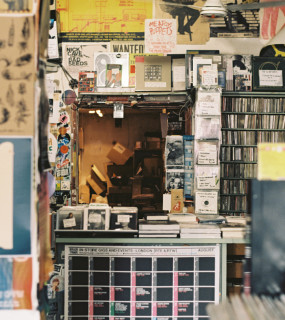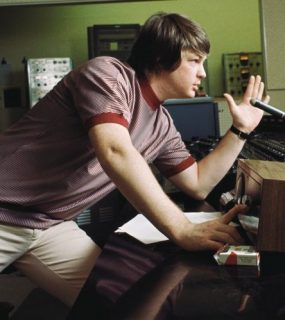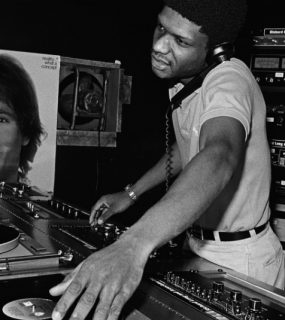Young The Giant: Something To Believe In
Orange County quintet Young the Giant is a modern-rock melting pot: Frontman Sameer Gadhia’s parents are Indian immigrants, bassist Payam Doostzadeh is Persian-American and drummer Francois Comtois hails from Quebec. Though the group hasn’t talked up their roots much before, nor gotten especially political, the band’s third album comes at a time when hyphenated Americans are reminded daily of their status. The lyrics of Home of the Strange reflect that, taking a stance while yet referencing a complex, ongoing identity crisis.
Read the rest of this article at Rolling Stone
Two Feet – Her Life
We’ve had our eye on enigmatic act Two Feet for a few weeks after we came across a few short demos of his, and, while he first started dropping material on his SoundCloud account a month ago, there’s been no real rhyme or reason to his songs. They’ve all been intriguing as hell, however, and we’re definitely glad to be able to share one of them with you today. “Her Life”, the name of that new track, is, compared to his other releases, the most complete-sounding ones we’ve heard yet. It’s the best indication of what potential the act has as well, so do yourself a favor, and keep as updated on him as we are going to be here. We’ve included one of our previous favorites from the act, “Go Fuck Yourself”, below, and if you’d like to check out the rest of his work, you can do so on his SoundCloud page now.
Read the rest of this article at Hillydilly
deadmau5 – Saved
Deadmau5 has released a majestic, space-like new track titled “Saved,” it’s the final version of a track the artist has been teasing for months.
The track is a sprawling epic that has all the hallmarks of classic mau5. It runs just short of 10 minutes in length and sees the introduction of orchestral bells, trademark synth arpeggios and more, before progressing into an otherworldly crescendo.
“Saved” was first uploaded to mau5’s Soundcloud account eight months ago, but this final (and much better) version will be the first single from We Are Friends Volume 5 (WAF005), the fifth installment of a Mau5trap compilation series that has featured songs from the likes of Eekkoo and Kairo Kingdom since its 2013 inception.
Read the rest of this article at High Snobiety
Florence + The Machine – Too Much Is Never Enough
Florence + the Machine have released three epic new songs recorded for the video game Final Fantasy XV. Singer Florence Welch teamed with producer Emile Haynie (Kanye West, Lana Del Rey, Bruno Mars) for the orchestral trio, which includes two originals – “Too Much Is Never Enough,” “I Will Be” – and a cover of Ben E. King anthem “Stand By Me,” Idolator reports.
Read the rest of this article at RollingStone
TENDER – Outside
London duo Tender is made up of James Cullen and Dan Cobb. They make darkly-shaded, R&B-inflected electro grooves. They’ve signed with Brooklyn-based Partisan Records, and to celebrate today they’ve come with “Outside.” It’s a pulsing, mid-tempo, textured song with deep-burrowing bass grooves, warped synths, and subtle, syncopated drums ridden by evocative melodies and harmonies. It’s alluring in its rawness and vulnerability, with provocative lines like: “I will touch myself, guilty of loving you too much/ I’ll smother you, just to feel your touch.” There’s some devastating sentiment cleverly wrapped in a sultry soundscape. Listen.
Read the rest of this article at Stereo Gum
News
B1966 could be rock ‘n’ roll’s most revolutionary year, thanks to the Beatles, Dylan and the Beach Boys

What’s the most innovative year ever for rock ’n’ roll? Fans, critics and academics have any number of watershed years they can point to in the more than six decades of post-World War II popular music broadly defined as rock.
There’s 1954, the year Bill Haley & His Comets’ “Rock Around the Clock” signaled the flashpoint of rock ’n’ roll, and Elvis Presley first stepped up to a microphone at Sam Phillips’ Sun Studio in Memphis, Tenn.
Or 1964, the year Beatlemania exploded around the world and the launch of the British Invasion.
Don’t discredit 1967, with the Summer of Love, the blossoming of flower power and psychedelic music.
Some stand by 1977, which saw the arrival of that “young, loud and snotty” music called punk rock.
The beginning of the modern era perhaps took flight in 1982, when Grandmaster Flash & the Furious Five’s “The Message” put rap music on the national map.
More recently, the case be made for 2001, which gave us the birth of iTunes and redefined — as well as broadened — how we listen.
Terms such as “best,” “most enlightening” or “most important” are all very subjective, of course. But 50 years down the line, a case can be made that 1966 may have been the single most creatively expansive year of all.
That was the year that “rock ’n’ roll” morphed into “rock,” the year that the 45 rpm single yielded to the 33 1/3 rpm long-playing album as the dominant medium for the music and the year that social and political issues became a regular topic of exploration among musicians looking beyond the next hit and aiming to exert a real impact on the world around them.
While rock ’n’ roll was already an established art form, 1966 was the year in which release after release challenged not just artists but also their fan bases. It’s the year, said Jason Hanley, vice president of education at the Rock and Roll Hall of Fame in Cleveland, that opened up a “whole new vista of promises of what rock ’n’ roll could be.”
Read the rest of the story at Los Angeles Times
How the Beach Boys Invented Surf Style

The Beach Boys introduced sunny Southern California’s aesthetic to pop culture, helping to make baggies and Woodies and surfing look and sound hip even in Kansas.
From Spicoli’s burner cool to every buff, bronzed, board bro character trope, California’s surf culture is as burned into pop culture as blond highlights are in sun and salt bleached hair. While wave riding itself has been happening for thousands of years, the modern American incarnation was born in the late ’50s with the popularity of Gidget and other beach culture B movies. It wasn’t until 1961, however, with the success of the Beach Boys’ first single, “Surfin’,” and subsequent 1962 album Surfin’ Safari (paralleling the simultaneous success of instrumental surf music by Dick Dale and others) that the sunny, sandy Southern California lifestyle became etched into the imaginations of even landlocked American teens with songs about girls and hot rods and road trips. While the movies gave a 90-minute glimpse into a magical, bikini-clad world and never-ending beach daze, now people had a soundtrack to play over and over again as they dreamed of wood-trimmed cars and endless white sand.
Composed of brothers Brian, Dennis, and Carl Wilson, their cousin Mike Love, and their friend Al Jardine, the band blended breathtaking harmonies, Chuck Berry-style rhythm, and lyrics extolling the sun-kissed Southern California life. The singles that resulted from this mash-up kicked off a musical revolution that would go on to be called the California Myth, and later the California Sound.
The Beach Boys, in one incarnation or another, still tour, but their most culturally influential era ran until about 1966 with the release of Pet Sounds, which has been hailed by Rolling Stone as second on their list of the 500 Greatest Albums of All Time. Ultimately the band moved away from the pure surf pop that sent them to the top of the music charts, but their early anthems to fun in the sun and surfing still account for their broadest cultural impact.
Read the rest of the story at The Daily Beast
You Should Be Dancing: The Art Of The DJ

An LA club that specialises in “underground house music” recently bannedDJs from using laptops, inevitably leading to a flurry of online responses. The club’s owner, Kenny Summit, was upset with laptop DJs not being able to plug their gear into the club’s system. He complained in an interview that DJs “don’t know what to connect with our Pioneer system; they have no clue what they’re plugging in or what plugs they’re taking out”. While Summit’s anger was aimed at amateur DJs, arguments were sparked between vinyl DJs, laptop DJs, and everyone in between over the legitimacy of laptops in clubs.
An old guard versus new guard debate over what DJs actually do and what theyshould do had been re-ignited.
The biggest contention in this twitter-finger war was over beatmatching. The technique involves blending two records to the same tempo to create a seamless mix, something that is much harder to do when using vinyl. On many modern laptops and digital mixing programs there is a sync button that automatically beatmatches – although its use is generally frowned upon. According to Seth Troxler, a DJ and prominent critic of “mainstream” dance music, “there are too many kids out there who actually don’t know how to beat match”, adding that this is the line between a “DJ and an entertainer”. Inherent in these remarks is the idea that a real DJ is much more than a mere entertainer; an artist perhaps?
And so the long debate over dance musicians in our culture continues. The issues are similar to those raised when CDJ devices first appeared on the market, replacing vinyl DJs, and also to those when vinyl DJs themselves replaced dance bands. As Sarah Thornton discusses in Club Cultures, the original dance musicians were highly skilled musicians whose livelihood was built around their virtuosity and wide song repertoire. From swing to rock’n’roll, and through much of the rock era, music for dancing was generally performed by a band who would play the latest hits for their audience. During this time, the playing of records began to replace the hiring of bands on the basis that you only had to hire a single DJ as opposed to a whole band, and they could theoretically play any track without having to learn it. The use of DJs was very controversial for a long time. As Thornton points out:
Read the rest of the story at Drowned In Sound




